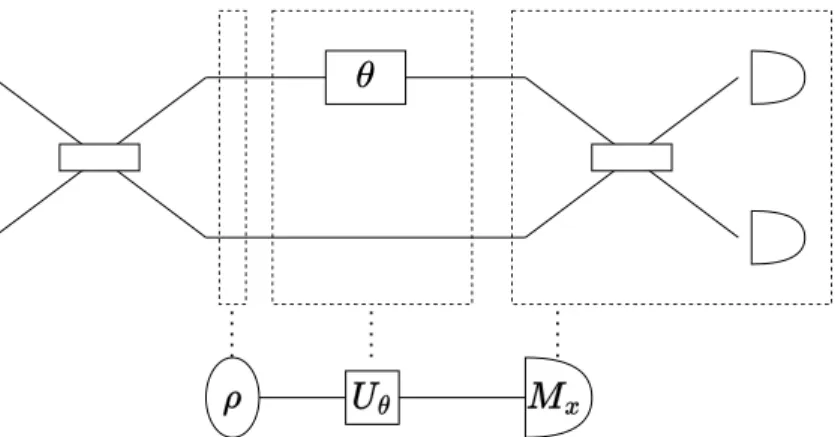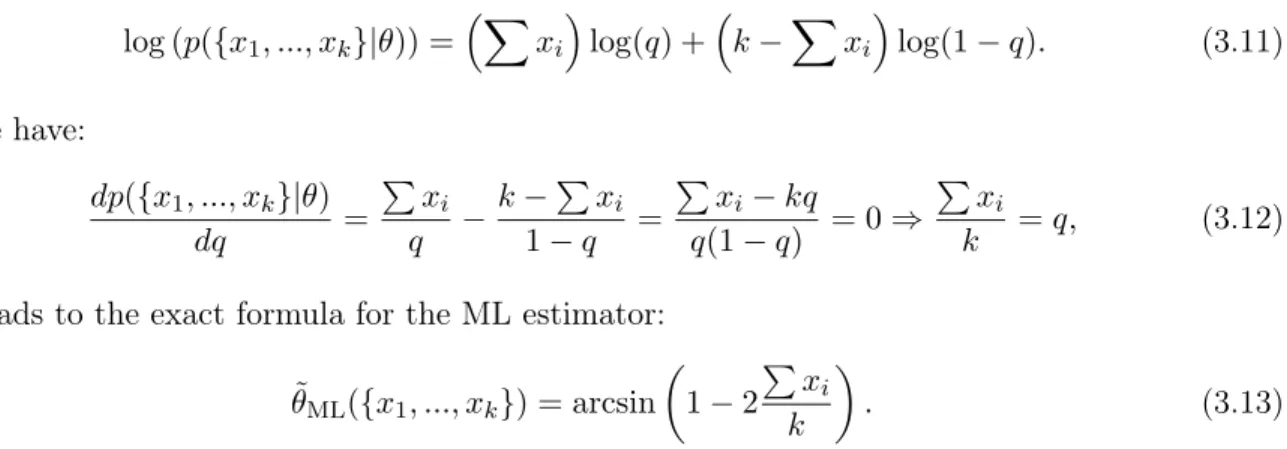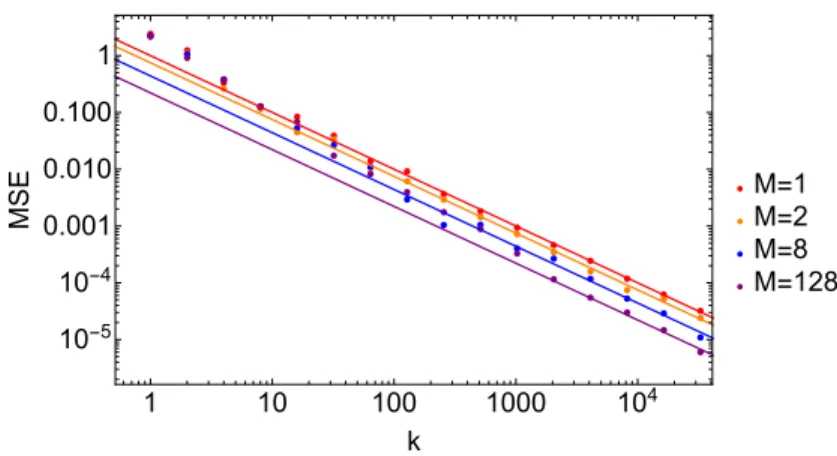Consequently, the optimal use of all resources implies that they are accumulated in a single run of the experiment. In this thesis, using the formalism of the Bayesian estimation and the minimax estimator, I derive asymptotically saturable bounds on the precision of the estimation for the case of silent unitary evolution. In the next part I analyze the Heisenberg limit problem when several parameters are measured simultaneously on the same physical system.
I also derive a lower bound on the achievable precision of the measurement in the general case (not always saturable). My sincere thanks go to Dominic Berry and Howard Wiseman, who began tackling the Heisenberg limit beyond quantum Fisher information long before me, whose publications inspired me, and in collaboration with whom I wrote the first of the papers that forms of this thesis.
Introduction
Heisenberg limit in quantum metrology
Major problems discussed in the thesis
An argument was put forward in 2011 [Hayashi[2011]] justifying that, in the limit of N going to infinity, this difference is independent of the magnitude of the [0,2π[interval. A second major problem related to the misunderstandings arising from the misuse of quantum Fisher information in the context of the Heisenberg limit is the accuracy that can be achieved when bounding only the expectation value of the total energy. Finally, I examine the issue of the Heisenberg limit in the context of multi-parameter metrology.
One of the aspects addressed is the comparison of the effectiveness of the combined measurement of all parameters simultaneously with the situation when they are measured separately. This paper discusses the issue of resource allocation and makes a comprehensive comparison of the results obtained using the two paradigms (QFI and Bayesian estimation theory/minimax approach).
Outline of the thesis
In 2012, it was shown for the general case that the MSE cannot decrease faster than quadratically with the mean energy [Giovannetti et al.[2012]], but the derived bound was not saturable. These results are based on the methodology and observations from my papers [Górecki et al.[2020], Górecki and Demkowicz-Dobrzański [2022a]], but they have not been published in explicit form before. In Chapter Two, I discuss the Fisher quantum information formalism, highlighting its strengths (such as the extensively developed theory regarding metrology in the presence of noise) while highlighting its limitations in the context of Heisenberg limit analysis.
In chapter three, I analyze Heisenberg's operationally feasible limit under constraints of the total amount of resources available in the system or of the average energy. I reproduce the proof of optimality of the entangled parallel strategy for the covariate problems [Chiribella et al. [2008b]], which I will need in the next chapter.
Quantum metrology and the Heisenberg limit
- Heisenberg limit by an example
- General formulation of the channel estimation problem
- The role of observable and optimality of projective measurements
- Average energy case and the inability to overcome the Heisenberg scaling
- Entangled-parallel and sequential-adaptive metrological schemes
As the results in such a scenario, we can only estimate the value of the parameter up to the term +m2πN (m∈Z). In the case where the mean value of the estimator indicates the correct value of the parameter (the estimator is unbiased): MSE is equal to the variance of the estimator. The problem of fully minimizing the MSE of the estimator, with constraint only on the total.
In the Bayesian approach, we introduce an a priori distribution of the value of the parameter p(θ) and consider Eq. as a measure of merit. Let us focus on such an example to introduce the notation for the rest of the thesis.

Fisher information and Cramér-Rao bound
- Classical Cramér-Rao bound
- Example – two arms interferometer
- Asymptotic normality of maximum likelihood estimator
- Quantum Cramér-Rao bound
- Quantum metrology – unitary evolution
- Infinite QFI for average energy constraints
- General theorem for a noisy estimation
This means that this measurement will also be optimal from a global point of view and will enable the efficient use of the ML estimator. In general, the measurement that maximizes classical FI may depend on the exact value of the parameter, so the above reasoning cannot be applied directly. For simplicity, let's start with the problem of uniform evolution, i.e. that which is given as U =eiθΛ. Given the convexity of the QFI, the optimal input state for any channel will be the clean state.
Therefore, the optimal state can be simply achieved by necting the gates on a single system copy: |ψnθ⟩= √1. Then the QFI of the output state maximized over the input state is bounded by [Fujiwara and Imai [2008], Demkowicz-Dobrzański et al.[2012]].

Obtainable Heisenberg limit in single parameter unitary esti-
- Bayesian and minimax costs
- Optimality of covariant measurements
- Interferometer with a fixed total number of photons
- Interferometer with a fixed average number of photons
- π -corrected Heisenberg limit
- Average energy constraint
We would say that the estimation problem is covariant (in either Bayesian or minimax approach), iff:. required in Bayesian formalism) a priori distribution is invariant under action of the group p(g)dg =p(hg)d(hg) – the prior is uniform with respect to the Haar measure on the group. For the simplicity of the notation, I further assume that dg is the normalized Haar measure, R. Then for a given input conditionρ with single use of the channel, the optimal cost is obtainable with covariant measurement, that is, the one of the form [Holevo,1982, Chapter 4]:. Therefore, it remains in the analog of the problem of the position shift estimation in continuous space, where the shift generator momentum operator is pˆ= 1idxd, while the optimal measurement is {|x⟩} (which can be obtained by applying Fourier transform to {| p⟩}).
On the contrary, in the case discussed in this section, the probability of obtaining the resultθ˜where the actual value of the parameter is θ is given as (for the optimal measurement of the covariance Eq. 2009]], it was proved analytically that the Heisenberg scaling with all sources N can be obtained from a proper measurement sequence for n00n states with different n in a different iteration, which was also demonstrated in the experiment [Higgins et al. The same problem can be discussed with a restriction on the average number of photons on the sensing arm, which is the constraint on the mean energy to realize ⟨ψ|H|ψ⟩ = N, as discussed in Sec.
However, this intuition fails: in [Hayashi [2011]] it was proved that, up to the front term, the optimal cost achievable in parallel strategy does not depend on the size of the initial interval. More precisely, in the minimax formalism minθ∈ΘlimN→∞N2∆2θ˜= π2, independent of the size of Θ (more details about the methods used in this paper will be discussed in Ch. 6). This would in fact be an alternative derivation of the bound Eq. 4.38), but only for the parallel strategies [Górecki and Demkowicz-Dobrzański [2022a]].
That's it - the finite bandwidth probability distribution of the bandwidth is the one that can be obtained assuming a completely unknown parameter by issuing N0 = L/(2λ) gates. In this section I will derive the analogous limit for the unit estimation problem with mean energy constraint, discussed in Sec. However, we can use the comment at the end (about an intuitive interpretation) to derive the boundary for parallel strategy (using ancilla).
Multiparameter metrology
Foundations
Fisher information matrix and multiparameter Cramér-Rao bound
The advantage of such a derivation is that it clearly shows the origin of the measurement inconsistency problem. The last inequality is proved to be asymptotically saturated for many copies of the system if collective measurements are allowed in all copies, i.e., p(x|θ) = Tr(Mxρ⊗kθ ) (see [Demkowicz-Dobrzański et al. 2020]] for both general proofs and simple examples). In contrast, for the pure state, the HCR can be saturated with local standard measurements in a single copy of the system.
In the case of one parameter, it was shown for uniform evaluation that the optimal adaptive scheme is sequential operation of the gate times, without the need for uniform control during Sec. 0 ⊗11 and the input state |ψ′⟩ ∈ HS ⊗ HA, where the auxiliary system is the same size as the original one, dim(HS) = dim(HA), for which the QFI matrix is greater than or equal to the QFI for the first strategy:. Let me now claim that it is possible to obtain at least the same QFI matrix with an ancilla of the same size as the physical HS system.
2008b]], saying that for the covariant group element estimation problem, the optimal strategy can be found as the covariant parallel one, i.e., there is no advantage in considering a more general adaptive sequential scheme. For the covariant group estimation problem, as an optimal strategy using N gates, one can always choose the parallel one with covariant measurement, i.e. the one of the form:. Next, let's derive the formula for the Choi matrix of channel composition.
Let's modify the unit channel by adding classical fluctuation of the parameter itself, namely Eg(ρ) = R. This covers, for example, the general problem of the phase shift estimation with the occurrence of dephasing noise. Note that the addition of such noise is not the crucial step of the proof Eq.
Heisenberg limit in multiparameter metrology
- Introduction
- Asymptotic equivalence of the global and local minimax cost
- Multiple-phase interferometer
- Magnetic field with unknown direction – SU (2) estimation
- General bound for precision in multiparameter unitary evolution
- Magnetic field in two spatially separated points
- Summary
To show that we need to justify that for the protocol minimizing LHS from Eq. 6.4), the probability of the gross errorθ˜−θ is negligible. For the problem of measuring all phases together, the exact solution of the problem is beyond our reach. That's it - the fact that one cannot achieve better scaling with p for this model by measuring all parameters together arises directly from the nature of the Heisenberg limit (understood in terms.
As the next example, I would like to discuss the estimation of three components of the magnetic field observed by spin-1/2 particles. Likewise, as in the introductory example, I assume the elementary gate is obtained by the field acting sufficiently short in time so that the rotation angle |θ| ≤π, so the problem boils down to estimating the rotation. As mentioned before, the variance of every single parameter. can be bounded by the inverse of the diagonal element of the QFI matrix: . 6.31).
Note that in this case the problem of measuring each of the three parameters separately is highly nontrivial, since, in contrast to the multiphase case, there is no subspace of the Hilbert space for which the evolution depends on a single parameter. A similar analysis can be performed for the problem of estimating only two components of the magnetic field, where the third one is known to be zero, namely Uθ = ei(θ1σx+θ2σy), which was analyzed in the covariant formalism in [Bagan et al. . The multiparameter estimation problem with optimal use of all N gates has a known analytical solution for some specific group estimation problems: SU(2)/U(1) [Bagan et al.
To make use of the above bound in the multiparameter case, let me discuss the concept of reparameterization. The analysis of the examples shows that, in contrast to the estimation of a single unit parameter, in the multiparameter case, there is no clear and unambiguous correspondence between the results obtained in the many repetition paradigm (analyzed within CR formalism) and those corresponds to the optimal use of all resources (analyzed using MM). On the other hand, the divergence of the conclusions obtained in the two paradigms regarding the gain from the joint measurement of the parameters is not related to commutativity.
![Figure 6.1: (Figure taken form [Górecki and Demkowicz-Dobrzański [2022a]]) p + 1 -arm interferometer with single reference arm and p sensing arms is given](https://thumb-eu.123doks.com/thumbv2/9liborg/13948818.1802066/73.918.286.635.110.414/figure-figure-górecki-demkowicz-dobrzański-interferometer-reference-sensing.webp)
Conclusion and outlook
Nevertheless, since we consider the case when the variance of the number of photons is much smaller than the square of its mean number, we do not expect any significant effects (in contrast to those of Section 3.6) arising from this fact. Therefore, the measure of quantum advantage is the value of the denominator in the above equation. The observed effect was minimally weaker2.15dB, which was identified as the result of normal fluctuation of the phaseϕ of order37±6mrad.


